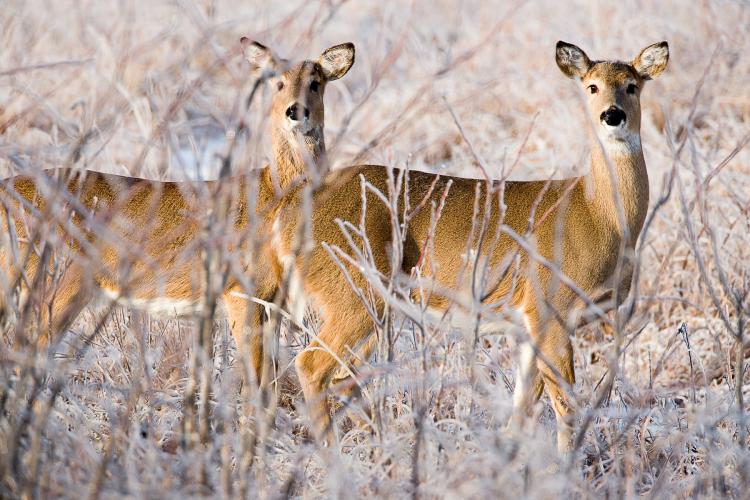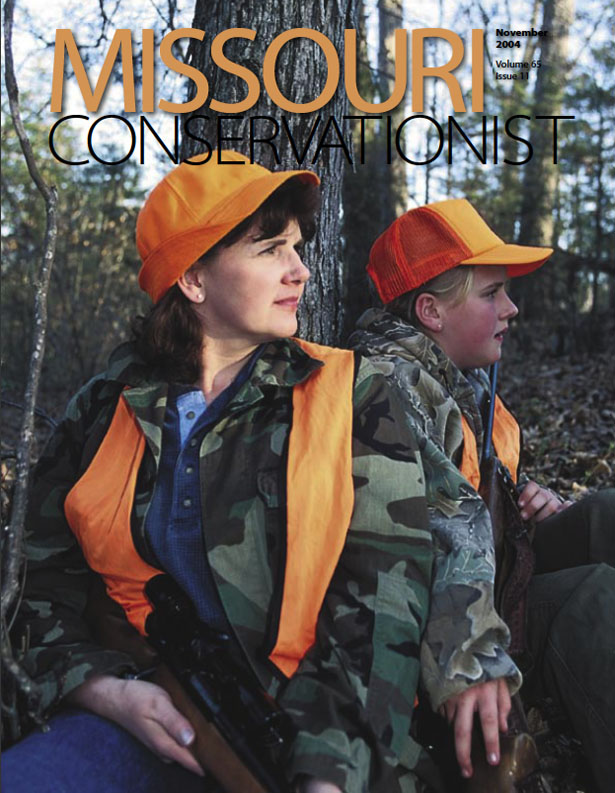Several years ago, I fired at the first deer I saw on opening day morning. The deer collapsed like the bullet had let the air out of it.
"Good shot!" I told myself and climbed down from the treestand to tag the deer.
I found the young buck easily in the knee-high weeds. He looked a little small, but I was glad to have filled my tag. Other years, I have not been so lucky.
Even describing the buck as "a little small" might still be an exaggeration. It was a button buck. Two fingertip-size nubs on its head showed where antlers would have grown. After I gutted it, I was able to lift the deer into the back of the truck without lowering the tailgate.
At the check station, I couldn't help but conclude that the hunters in line with me had seen larger deer than I had. I was comforting myself with the thought that it was just the luck of the draw, when a little girl sitting on an old man's shoulders stared into the back of my truck and said, "Oh, look, Grandpa! It's just a baby!"
Once free of the check station, I drove straight home. I'd already decided to butcher the deer myself. Processors charge by the deer, not the pound. Paying the full fee for such a small deer didn't make sense to me.
Don't get me wrong. I was happy I'd shot a deer and, at the end of a long day in the kitchen, had venison in the freezer. However, one single thing would have made the day much more satisfying--a bigger deer.
BIGGER DEER
There are many more young deer than adult deer. Adult does in Missouri usually have two fawns per year, and about half of the female fawns born that year will give birth around the time of their first birthday.
A deer--buck or doe--generally doesn't approach the 100-pound mark until its second year and won't reach its top weight until it is about 4 or 5 years old. Because of hunters and other threats, only a small percentage of deer--especially bucks--reach their peak size. As the record books show, however, the Missouri deer that man-age to reach their potential weight are real trophies.
TROPHIES
During a series of public meetings this year, many Missouri citizens and hunters expressed their desire to see larger bucks. The best way to achieve this through management is to shift harvest pressure from bucks to does. Taking more does and fewer bucks raises the percentage of bucks in the population. It also allows more bucks a chance to grow big antlers.
For years, the Conservation Department has restricted the number of bucks that hunters could harvest. This year, new restrictions create a kind of "slot limit" for bucks. In 29 counties in the state, hunters aren't allowed to harvest bucks ranging from "spike" bucks with 3-inch or longer points to bucks without at least four points on one side of their rack.
Controlling doe numbers is key to keep-in a deer population in check. The new regulations should work, but it will help if hunters avoid shooting those small bucks.
SMALL BUCKS
Although legal, taking a small buck with nubs, or with points less than 3 inches long, doesn't contribute to our efforts to balance the deer herd. It just takes another buck out of the population.
Targeting bigger deer helps you avoid shooting young bucks. It's easy to tell whether a big deer is a buck or a doe, but buck and doe fawns are difficult to tell apart. Buck fawns do grow faster than doe fawns, but that just makes them more vulnerable to hunters, who usually will shoot the larger of a pair of fawns. Young buck fawns also are more aggressive and curious, making them easier targets.
Shooting the small buck also keeps you from filling your Antlerless Permit with a doe. Last year, more than 26,000 Firearms Antlerless Permits were filled with button bucks. This unintentional buck harvest slows attempts to balance the population by limiting the production of the deer's fawn factories.
FAWN FACTORIES
The older the doe, the more fawns it produces. One-year-old deer average only about 1/3 of a fawn per doe. The average jumps to 1 3/4; fawns per doe the following year, and then it steadily increases nearly 2 fawns per doe for deer by five years of age.
Mature deer also make better mothers. Studies show that the chances of fawn survival increase with the age of the mother. Lots of factors likely contribute to the improved odds. The larger the deer, the better able it is to defend against or intimidate predators. Older deer also may command more favorable home ranges and, through experience, have learned where to find food and safety for themselves and their fawns. In other words, they are smarter.
SMARTER THAN BUCKS?
Linger where deer hunters gather, either in sporting goods stores or in internet chat rooms, and you're apt to run into the long-running argument about whether a mature doe is smarter than a wise old buck.
Any deer--buck or doe--that reaches maturity has demonstrated intelligence and has likely learned a lot about survival. Older does, however, have shown a special kind of savvy. Not only have they survived, but they have helped their young and other deer traveling with them escape danger.
Hunters consider old bucks wise, because they generally travel in thick cover and usually late at night. However, bucks don't feed nearly as much during the rut, which roughly corresponds to the hunting seasons. Because they are not reliably traveling to feeding areas, they are harder to pattern and ambush.
Does, on the other hand, have to put enough weight on in the fall to sustain themselves and their gestating fawns through winter. This forces them to frequently visit feeding areas and bed down near them. Generally doe movements are more predictable than bucks.
This is not to say a mature doe is easy to hunt. Does seldom let down their guard, and mature does seem especially vigilant.
Bucks are legendary for being careless, even acting a little stupid, during the hunting season. I've seen them pace noisily back and forth on a ridge for more than a half hour, and I've spooked away bucks only to have them return a short time later. I once dropped a thermos from a tree stand, and a buck I hadn't seen marched right up to sniff it.
Bucks may be as smart as does, but during the fall, they fall victim to hormones and instincts. While does seem to spend most of their time looking for danger, bucks seem to travel with their noses to the ground. The biggest racked deer I ever took walked so close to me that all I could see was deer hair in my scope.
I waited until he passed and then took him--an easy target and a nice wall rack. During the next year, I spent a lot of time bragging, but I also spent a lot of time chewing. That was one tough deer.
TOUGH DEER
An old saying goes, "you don't eat antlers." Back when hunting camps were popular, hunters often shot a doe for camp meat. The prime fare provided by the doe fueled them for hunting "trophy" bucks.
Venison from breeding bucks is almost certainly going to be tougher than doe meat. At the very time when does are fattening themselves for winter, bucks are running themselves ragged, chasing does and fighting other bucks. During the rut, a buck's food consumption drops about 50 percent. In fact, breeding bucks can lose 25 percent of their body weight during fall.
During a taste study in Texas, most of the participants favored venison from does over venison from bucks. After mining those surveyed for more information, the researchers concluded that venison from does had less "flavor intensity."
That's a researcher's way of saying it isn't as "gamey."
You can mask tough, strong-tasting venison with marinades and spices, or you can have it made into sausage or jerky. These specialty meats taste good, but you will have to pay a premium for them, and you will be missing out on the sweet, delicate flavor of meat from a fat doe. For many hunters, venison for the family table is the primary incentive for hunting.
HUNTING FOR DOES
Years ago, only bucks were fair game. Hunters grew up believing that good conservation demanded that does be left for "seed" to build up the population. Hunting regulations and the belief of hunters that shooting does was wrong helped create the great deer hunting we have today.
Times have changed. We now have a healthy deer population in Missouri, and good conservation requires maintaining it at a sustainable level. This requires a change in both regulations and hunter attitudes.
Taking does need no longer be taboo. In fact, the Conservation Department is encouraging hunters to take more does and leave the bucks to "seed" a more balanced population. From a conservation standpoint, the big does that hunters bring into check stations are the best trophies of all.
TARGETING MATURE DOES
Mature does seldom travel alone. Deer society is matriarchal, with the dominant doe in charge.
When entering a field or opening, the older doe often leads the group into a field or opening. It is also usually the first in a file of deer moving along a trail.
Watch closely for subtle movement. Mature does tend to sneak away from potential danger rather than run away from it.
Make sure you have a killing shot. Although doe venison is generally better than buck venison, the gaminess of the meat increases if the animal runs long distances after being hit.


And More...
This Issue's Staff
Managing Editor - Bryan Hendricks
Art Director - Ara Clark
Artist - Dave Besenger
Artist - Mark Raithel
Photographer - Jim Rathert
Photographer - Cliff White
Staff Writer - Jim Low
Staff Writer - Joan McKee
Circulation - Laura Scheuler






















